Hello fellow Ghost Readers!
Welcome back to my Substack, and Happy Halloween! Next week I’ll resort back to posting on Fridays, but since ‘tis the season I have raised myself from my grave to write this - Part II of my foray into literary headlessness - especially for this spooky occasion!
This time we’re examining male headlessness. If you didn’t get a chance to read Part I (on female headlessness) it’s linked at the end, but don’t worry, it doesn’t matter what order you read them in so you needn’t click away if you’re feeling particularly anxious to hear about decapitated men.
***Once again I have to mention that this one gets bloody, and also includes references to sexual assault. It certainly won’t be the last gory piece I write as someone who’s specialist research interest was the Gothic body, but, if you’re not really feeling gruesome decapitations right now, you can go back and read my last two pieces if you haven’t already where we just look at some nice poetry.***
For those of you remaining, let’s crack on!
A ghost reader 👻
The most famous decapitated male body in literature is surely Washington Irving’s Headless Horseman. The ghost of a Hessian soldier who, having been decapitated in battle by a Continental cannonball during the American Revolution, supposedly haunts the small settlement of Sleepy Hollow - allegedly having been seen charging through the town as though recreating his final ride, before vanishing in a flash of flame.
Tim Burton’s Sleepy Hollow (1999) positions the main character, Ichabod Crane, as a modern-age hero - a police officer convinced of the powers of reason over emotion, and emerging forensic science over guess-work in his crime-fighting duties. He rides into town from cosmopolitan New York to rescue the townsfolk with his sharp mind for a sword. But Irving’s Ichabod was a little less cubic zirconia. A humble school teacher, choir master and part-time labourer, believing zealously in the legitimacy of the supernatural phenomena, and possessed of not enough coin to rent his own rooms. Though he fancies himself an educated man, a good singer and fine dancer, the narrator never directly confirms this. As a teacher he punishes bigger boys over weaker ones. He, himself, is tall and lanky, described as a scarecrow, with a seemingly insatiable appetite. He desires the hand of Katrina Van Tassel in equal parts because she is rich and eligible, and because her estate includes a lot of animals that Ichabod wants to eat. Any sexual fantasies he harbours for Katrina are displaced and fetishised as vore (if not explicitly cannibal play) in his thoughts of meat eating, but such fantasies focus on the cooking of the meat (read: feminine meat), rather then its butchering (masculine meat).
Ichabod clearly embodies the emasculation enlightenment ideology was sometimes accused of, especially when stood next to Abraham ‘Brom Bones’ Van Brunt who represents the classical masculinity of the ancients, and who claims to have raced the Headless Horseman and lived to tell the tale. Strong, handsome and likeable, possessed of excellent equestrian skills and Katrina’s affections. By comparison, Ichabod has to borrow a moody, flea-bitten, partially blind horse named Gunpowder to visit Katrina, who is so small that Ichabod’s lanky frame looks like a grasshopper atop him. (***Of course, it’s no accident that Ichabod’s horse is named Gunpowder considering the circumstances of the Horseman’s death, but this piece is already becoming quite long and I have more than enough material to cover to make my point without getting into phallic projection, so I trust it to your imagination***). In this story, the real spectre of this story is masculinity. From Ichabod’s perspective, Brom is functions very similarly to the spectral threat of the Headless Horseman. Brom threatens Ichabod’s ability to eat (Katrina’s) meat, since voracious consumption is the only way he can express patriarchal dominance. His own fantasies of eating meat function as a desire to compensate for his metaphorical impotence (even castration), but this desire is ultimately subverted as the concept of taking ‘meat’ into the body functions also, in the context of this impotence, as fundamentally yonic. To put it bluntly, Ichabod’s desires really centre around the fantasy of being filled by Katrina’s meat.
Similarly the Horseman threatens Ichabod’s ability to see his own body as anything other than meat. The Horseman represents a kind of masculine body totally defined by thumos - the masculine-coded Greek expression for ‘spiritedness’, what we might think of as ‘drive’ or ‘tenacity’ today, but relating to specifically to men. This was an admirable quality in a man, desirable in war, but also within wider societal roles. Interestingly enough the thumotic male body is almost indistinguishable from that of a horse. Artistic expressions of thumos usually depict some beefcake atop a charging stallion - the horse representing the wild, unbridled (though not literally) energy of the thumotic man. The thumotic man is a ‘do-er’, not a ‘thinker’ - a man of action, energetic and powerful. We cannot read the moment the Horseman unseats the fleeing Ichabod from his saddle using his own severed head as anything other than a grotesque parody of the classical masculine ideal, which sits at the other end of the novel’s proposed spectrum of masculinity, with Ichabod’s proud, ‘intelligent’ gentility at the other. No longer a tool for reason, strategy, even civilised cultivation, the head becomes a literal weapon, used effectively to separate Ichabod from his horse, and, by extension his own (albeit rather feeble attempts) at projected thumos. His own head (the place of intelligence) having proved useless in the face of a flying one, Ichabod confronts a reckoning with his body without a head. Metaphorically decapitated, his ‘headless’ body effectively becomes a purely physical piece of meat - an unthinking, undistinguished body destined for consumption (bi it literal or metaphorical).
Worse even. For when the townspeople discover Ichabod missing the next day, the only evidence they discover is his discarded hat alongside a smashed pumpkin. The insinuation is that both Ichabod’s body and his head (both represented by the be-hatted pumpkin) is not even man enough to be considered a dead body (meat), and instead is no better than a vegetable.
It is interesting to me that the most famous and enduring depiction is one which is defined by heightened ‘masculinity’ (even if it takes place in a male body which is presented as being grotesque, dead and haunted), and there seems to be something in this that resonates with the masculine ideal. On a very basic level we might suggest it points towards the separation of this ideal between the heroic body, and the brilliant mind.
Sir Nicholas de Mimsey-Porpington - or as he is more widely known, 'Nearly-Headless Nick’ - we find forlorn upon our first introduction, having had his request to join the Headless Hunt (another allusion to the thumotic horse-y-ness of masculinity) denied once again because he is not headless enough. He, like Ichabod, desires the full embodiment of heroic masculinity that his fully headless friends depict, but is instead forced to use his head.
We might conclude then that the true source of anxiety for Nearly-Headless Nick is not that he is not headless, but that he is nearly headless. The thumotic body alone is not the only ideal strived for by male characters. Cut loose from the base, grotesque limitations of the body, the severed male head is free to explore the reaches of it’s own masculine powers - unbridled intelligence and even magical power. Poor Nick is ‘emasculated’ because he straddles both ideals and successfully embodies neither.
The severed male head can be a desirable object - or, I should say, a desirable way through which masculinity might manifest itself. We are, surely, all familiar with the use of ‘talking heads’, usually within the context of ‘intellectual’ media such as documentary making. The premise itself - having some expert shown on camera from the shoulders up talking about their expertise - makes a certain amount of logistical sense, as well as being the de facto standard for the portrayal of information through this medium, but the deeper implications are self-evident. The head is the space of logic and reason, of intellect un-hampered by the demands and distractions of the body. This is not necessarily a gendered effect, but more often than not, the literary manifestations of this phenomena are male.
One of the more powerful, and self-aware of these depictions is the Wizard of Oz’s big, green illusion. With his booming baritone, smoke machine and pyrotechnics, Dorothy and her friends can’t help but be overawed by their first impression of the Great and Powerful, and are initially disappointed to discover that the man behind the curtain actually has a body. This of course is used to demonstrate the moral of the story for Dorothy and her friends, and, no doubt, for countless little girls and boys all over 1930s America - that each of them has had the thing they truly desire, the thing that they need to feel human, all along. But it is not clear that the Emerald City, and the world of Oz beyond it, is a place which always subscribes to this idea, however pretty it might seem.
Ultimately Dorothy’s narrative concludes that the body - any body, be it scarecrow, tin-man, beast or girl - is better whole. That reaped matter can think; that a machine can feel - The Wizard of Oz argues that this is better than any amputated body part. Indeed, all of Dorothy’s friends represents an aspect of her own identity which she believes/has been told she lacks. In Oz her identity fractures and reunites as a united cadre on a quest for itself (ie. self-unification). And yet, it still implicitly acknowledges that the image of the decapitated head is more powerful - indeed, a far more effective tool of statecraft - than one clever, able-bodied man. The wizard, by all accounts is not encouraged to change his ways as a result of the discovery of his body. Sure, the big reveal is a useful thematic tool for illustrating the lesson that Dorothy and her friends need to learn, but this revelation does not bring down the power structures of the city. It’s not even clear if the wizard even ditches the head gimick for the wider public once she’s left. Simply put, the disembodied glowing green head is never acknowledged as being somehow less politically capable than a full human. In fact, it’s tacitly accepted that it’s better, hence the decision of Oscar Zoroaster Phadrig Isaac Norman Henkle Emmannuel Ambroise Diggs (‘O.Z.P.I.N.H.E.A.D.’ or ‘Oz’ for short) to manifest as such in the first place.
Whatever narrative message Dorothy might glean from the whole experience, The Wizard of Oz never directly disputes the fact that the severed head is a powerful thing. More than powerful, it is even magical. Alice in Wonderland’s Cheshire Cat is a less conventional depiction of a male (or at least male-coded) head. Of all the characters in Wonderland, the Cheshire Cat is probably the character with whom Alice gets on best. Indeed, in terms of the corporal themes of the narrative, the Cheshire Cat effectively functions as her shadow-self. Alice spends a great deal of the narrative battling with the ever-changing proportions of her body, having fallen into an impossible land and essentially trying to prove to herself that she is real. ‘I'm afraid I can't explain myself […] Because I am not myself, you see?’ She famously says. All of the metrics by which Alice defined her ‘self’ are non-existent in Wonderland - the little girl from London has effectively disappeared. Likewise, the body of the Cheshire Cat moves between existence and non-existence, often appearing as just a head, or a wide, even predatory grin. Being a Wonderland. native, the cat has managed to harness the mutability of form and transform it into an act of intellectual predation - not a cat toying with a mouse, but a mind toying with another not in possession of the same measurable grasp on (un)reality, as it amuses itself by frustrating Alice with his/it’s perplexing metaphysical discourse.
Interestingly, the most horrific cultural stories of male decapitation - the ones where the act takes place on the page - take place at the hands of women.
There are many tales of male lust which end with their own beheading at female hands. Judith, for example, who seduced Holofernes in order to get close enough to him to decapitate him and save her people from siege. Salome’s dancing is enough to earn her the head of John the Baptist from Herod. Samson and Delilah also is first and foremost a castration metaphor, but the fact that it takes place upon Samson’s head is no accident. It feels a little boring, but it almost seems that male-on-female decap. fantasies really just speak to the fear of female agency. Quite a pedestrian conclusion to come to, but there it is. How predictable.
[I could write more on this theme, but as it turns out decapitation seems to be something of a theme on Substack this Halloween and Brie Lee has just today written an excellent post on this very subject (linked below), so go check that out because it’s very interesting and thorough and my hands are tired]
But, whatever we might conclude about the decapitated man when he comes into contact with the opposite sex, the ubiquity and favour with which masculinity seems to identify with this form ultimately leads us to conclude the strange truth that it is better separated from its head.
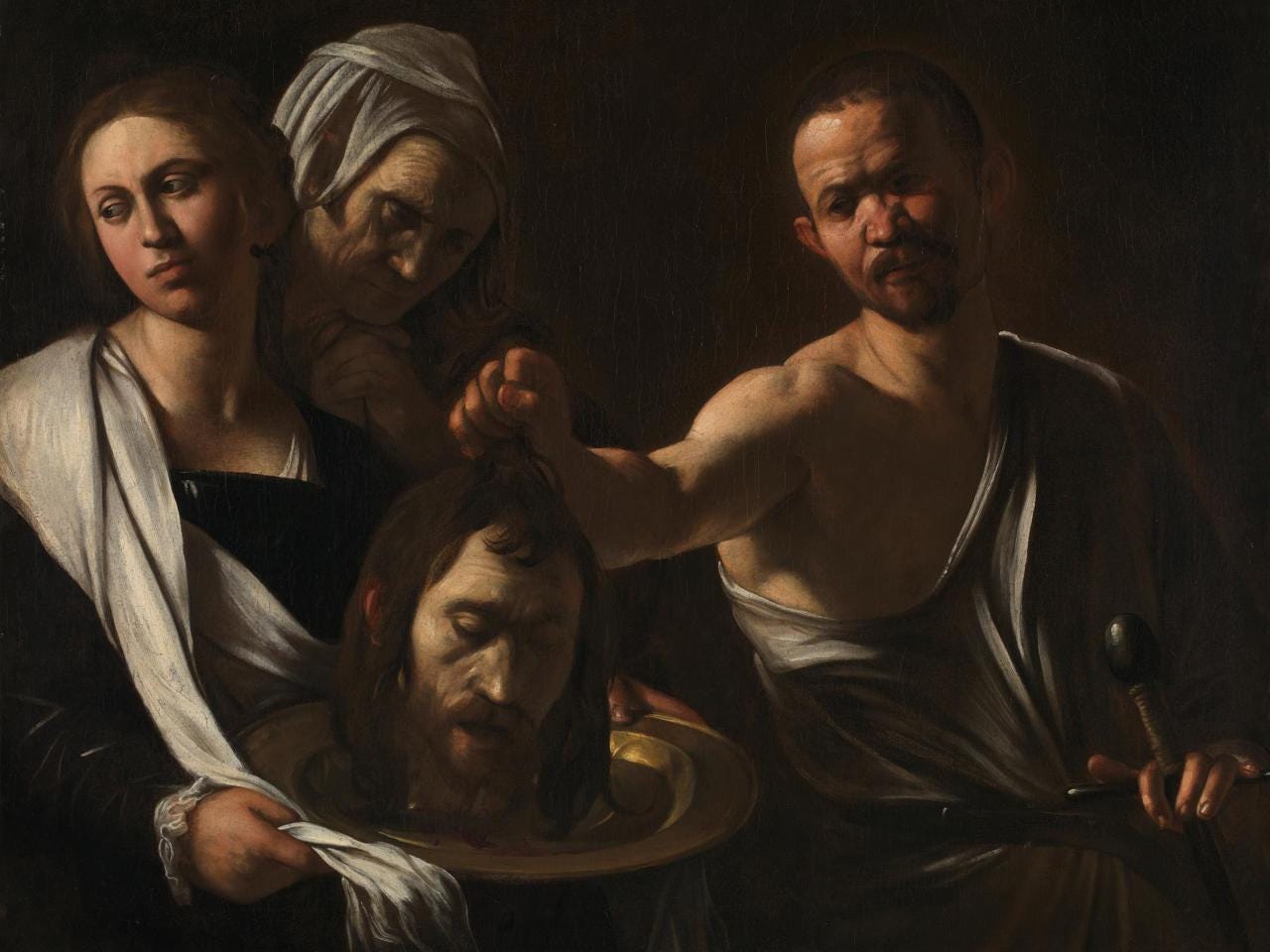
Brie Lee, ‘Heads Will Roll: Women, Power, and Severed Heads in Art History’. Available at":
https://substack.com/home/post/p-150679878?source=queue


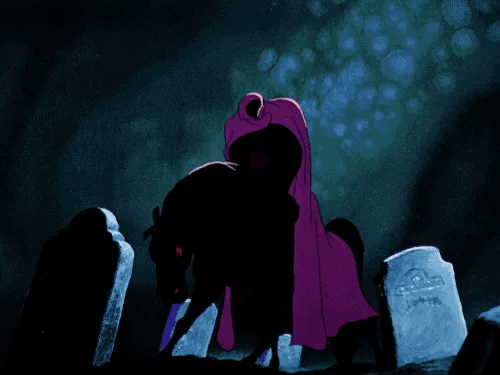
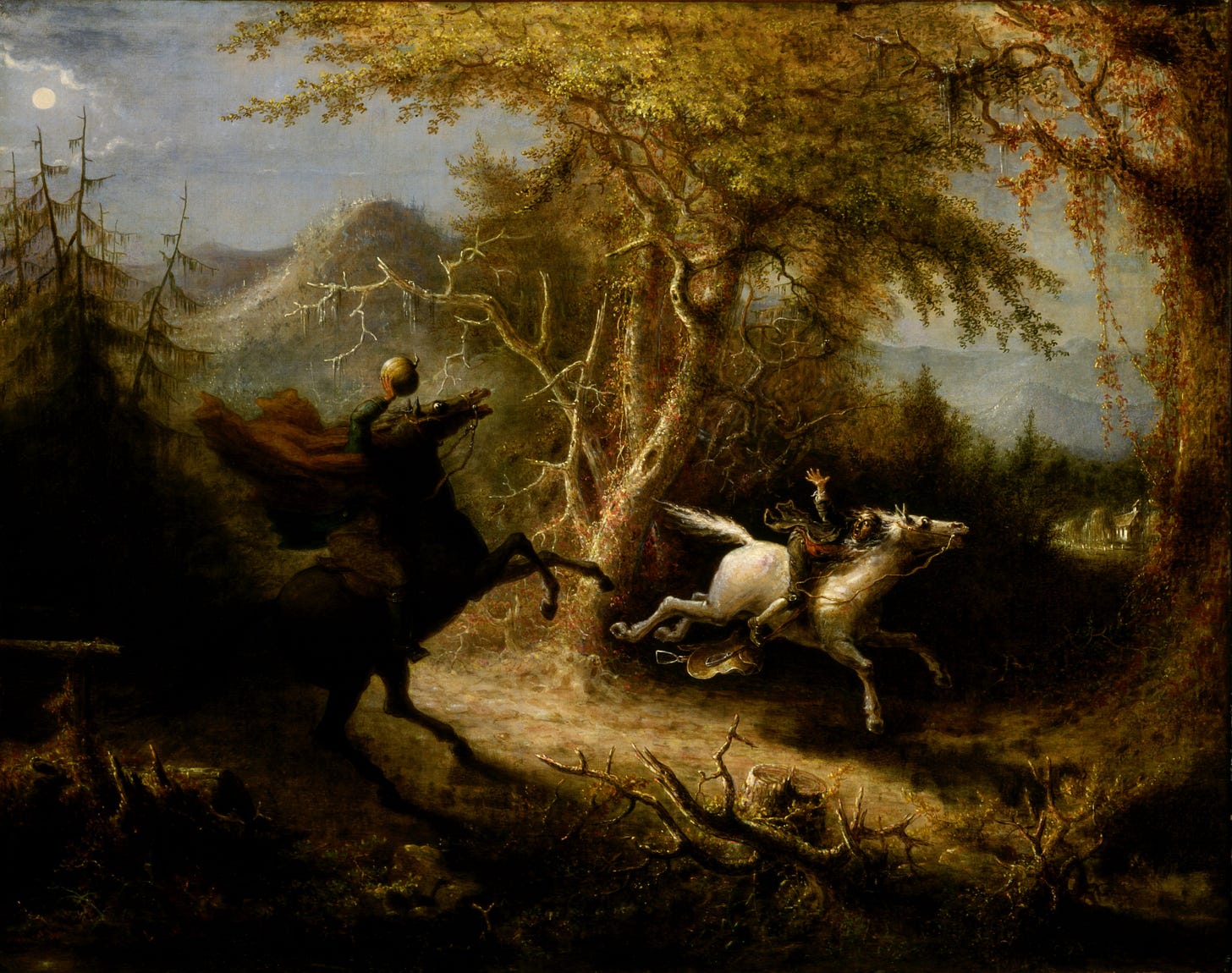
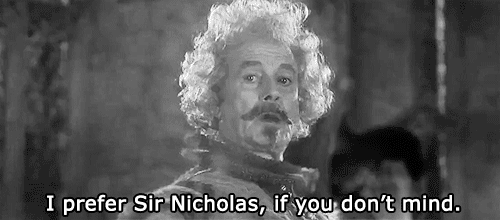
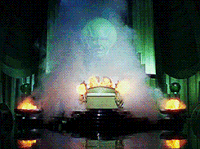
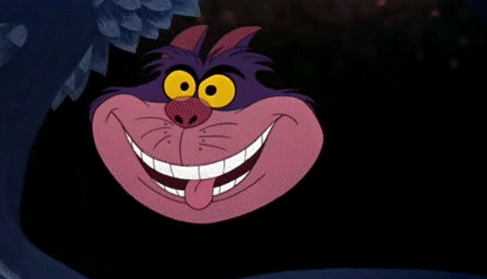
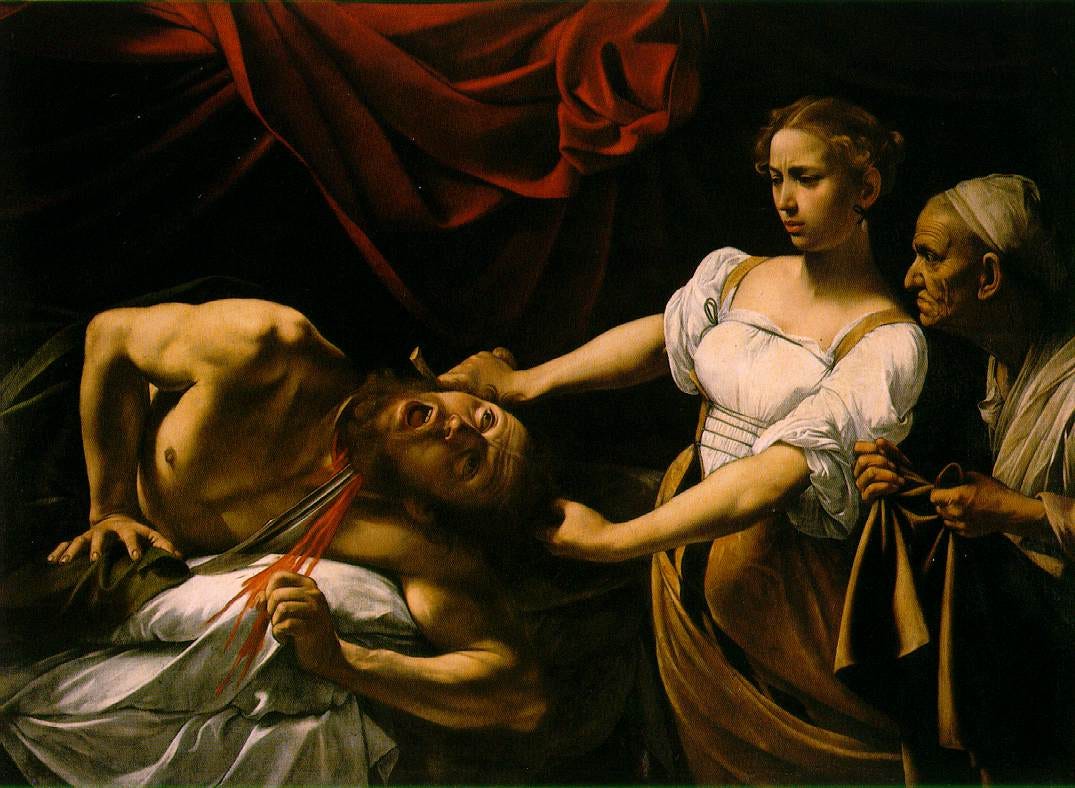

despite being someone who thinks about gender in pop culture CONSTANTLY, I hadn't made this connection!! but it makes so much sense for the male body to be an extension of the Physical and the Spirit (tied to considerations of innately "masculine" qualities, of course decided by men), and the male head to be an extension of Nobility and Reason (recognized for its power, but not its vitality). there's the scene in The Adventures of Baron Munchausen with the King of the Moon, who despises his detached body for its physicality and "stupidity." I could act smart and say that was the first thing I thought of, but I really thought of Futurama's depiction of Spiro Agnew: A screaming, violent body, only there to enact the physical power that the head of Nixon cannot. Once again, you've presented a new outlook on media that I won't be able to remove from my silly little thoughts!!